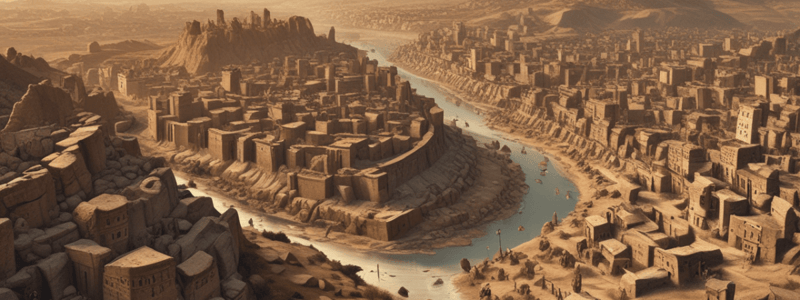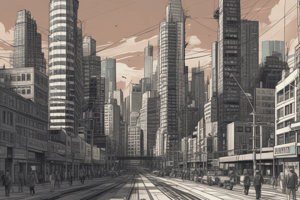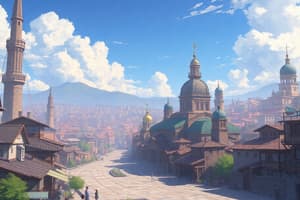Podcast
Questions and Answers
What are the three main factors contributing to the natural growth of a city?
What are the three main factors contributing to the natural growth of a city?
- Social problems, crime, and poverty
- Economic growth, urban planning, and environmental factors
- Urban expansion, immigration, and succession (correct)
- Transportation development, geographic environment, and government policies
According to the concentric zone model, what type of housing can be found in Zone 2?
According to the concentric zone model, what type of housing can be found in Zone 2?
- Thrifty workers' homes and convenient access to work
- Rooming houses and deteriorating housing (correct)
- Expensive apartments and single-family homes
- Commuters' homes in suburbs or satellite cities
What is a characteristic of cities that follow the sector model?
What is a characteristic of cities that follow the sector model?
- Limited transportation development
- Clear central business districts
- No suburban or satellite cities
- Zones with different land uses, such as working-class homes and businesses (correct)
Which city is an example of a multiple nuclei model?
Which city is an example of a multiple nuclei model?
What is the main argument of the growth machine theory?
What is the main argument of the growth machine theory?
What is a consequence of urban growth according to the growth machine theory?
What is a consequence of urban growth according to the growth machine theory?
What determines the distribution of people within a city according to the growth machine theory?
What determines the distribution of people within a city according to the growth machine theory?
What is a limitation of the concentric zone model?
What is a limitation of the concentric zone model?
What is a characteristic of cities that do not fit perfectly into the urban growth models?
What is a characteristic of cities that do not fit perfectly into the urban growth models?
What is a key difference between the growth machine theory and urban ecology?
What is a key difference between the growth machine theory and urban ecology?
What is a common challenge cities face during periods of rapid growth and transition?
What is a common challenge cities face during periods of rapid growth and transition?
What is the main difference between the concentric zone model and the sector model?
What is the main difference between the concentric zone model and the sector model?
In the multiple nuclei model, what is a characteristic of the different nuclei?
In the multiple nuclei model, what is a characteristic of the different nuclei?
What is a key factor that drives urban growth according to the growth machine theory?
What is a key factor that drives urban growth according to the growth machine theory?
What is a limitation of urban growth models?
What is a limitation of urban growth models?
What is a common consequence of urban growth in areas with significant movement of incoming and outgoing people?
What is a common consequence of urban growth in areas with significant movement of incoming and outgoing people?
Which of the following best explains the difference between the concentric zone model and the sector model?
Which of the following best explains the difference between the concentric zone model and the sector model?
What is a key factor that influences the distribution of people within a city according to urban ecology?
What is a key factor that influences the distribution of people within a city according to urban ecology?
Which of the following cities is an example of a city that does not fit perfectly into the urban growth models?
Which of the following cities is an example of a city that does not fit perfectly into the urban growth models?
What is a key characteristic of cities that follow the multiple nuclei model?
What is a key characteristic of cities that follow the multiple nuclei model?
Flashcards are hidden until you start studying
Study Notes
The Early Days of Urbanization
- Cities have been around for thousands of years, with the first cities emerging after the Neolithic Revolution when people shifted from a nomadic lifestyle to a lifestyle of farming and settlement.
- People gathered around water sources, such as rivers and lakes, and built non-nomadic or permanent settlements, which gradually expanded into small cities.
- Densely populated settlements emerged, along with specialization and division of labor among people living in the city.
- Trade, bartering, or other forms of economic exchange also took place, and architecture, centralized administrations, and political structures became part of a city.
Growth of Cities
- Two hundred years ago, only Beijing, China had a population of over one million people, but today, there are over 500 cities with over a million people.
- The Industrial Revolution contributed to the development of faster means of transportation and communication methods, allowing cities to exist and grow.
- As more cities formed, an increasing proportion of the population moved into cities, a phenomenon known as urbanization.
- In 1800, only 3% of the world’s population lived in cities, but by 2008, more people lived in cities than rural areas.
- Urbanization has been occurring especially rapidly in less developed parts of the world.
Why People Move to Cities
- People have become less attached to land as a means of production, making cities more attractive for job opportunities.
- Cities offer a wide variety of jobs and products and services for their residents.
- The development of schools has made education more accessible, increasing the importance of human capital (knowledge and creativity).
Cities in the US
- The US was largely rural in the beginning, but today, 80% of Americans live in cities.
- The top 5 growing cities in the US are Raleigh, Las Vegas, Provo, Cape Coral-Ft. Myers, and Greeley, while the top 5 shrinking cities are New Orleans, Youngstown, Cleveland, Detroit, and Flint.
- Edge cities have appeared, which are clusters of houses, stores, and hotels located near major highway intersections, often without their own mayors and belonging to a bigger city or town.
Urban Development Patterns
- Gentrification is a prominent phenomenon in the US, where the middle class moves into under-maintained areas of a city, driving up rent prices and displacing the poor.
- Suburbanization is another pattern, where residents migrate to suburbs, which are communities adjacent to but outside of the city, often becoming car-dependent.
Urban Growth Models
- Urban ecologists study how residents adapt to their environments and how cities form as a result of natural growth.
- The concentric zone model describes how a city grows from the center outwards, with different zones containing different types of housing and activities.
- The sector model is an updated version, taking into account transportation developments and how cities expand outwards along railways, highways, and water.
- The multiple nuclei model describes how a city may have several centers of business districts, with each nucleus containing specialized activities.
Growth Machine Theory
- Some argue that a city is a growth machine, driven by a coalition of interest groups who benefit from a city’s continuous growth and expansion, rather than the outcome of a natural process.
- The growth machine theory points out that urban growth is driven by social, political, and planned actions, rather than geography, transportation, or space.
The Early Days of Urbanization
- Cities have been around for thousands of years, with the first cities emerging after the Neolithic Revolution when people shifted from a nomadic lifestyle to a lifestyle of farming and settlement.
- People gathered around water sources, such as rivers and lakes, and built non-nomadic or permanent settlements, which gradually expanded into small cities.
- Densely populated settlements emerged, along with specialization and division of labor among people living in the city.
- Trade, bartering, or other forms of economic exchange also took place, and architecture, centralized administrations, and political structures became part of a city.
Growth of Cities
- Two hundred years ago, only Beijing, China had a population of over one million people, but today, there are over 500 cities with over a million people.
- The Industrial Revolution contributed to the development of faster means of transportation and communication methods, allowing cities to exist and grow.
- As more cities formed, an increasing proportion of the population moved into cities, a phenomenon known as urbanization.
- In 1800, only 3% of the world’s population lived in cities, but by 2008, more people lived in cities than rural areas.
- Urbanization has been occurring especially rapidly in less developed parts of the world.
Why People Move to Cities
- People have become less attached to land as a means of production, making cities more attractive for job opportunities.
- Cities offer a wide variety of jobs and products and services for their residents.
- The development of schools has made education more accessible, increasing the importance of human capital (knowledge and creativity).
Cities in the US
- The US was largely rural in the beginning, but today, 80% of Americans live in cities.
- The top 5 growing cities in the US are Raleigh, Las Vegas, Provo, Cape Coral-Ft. Myers, and Greeley, while the top 5 shrinking cities are New Orleans, Youngstown, Cleveland, Detroit, and Flint.
- Edge cities have appeared, which are clusters of houses, stores, and hotels located near major highway intersections, often without their own mayors and belonging to a bigger city or town.
Urban Development Patterns
- Gentrification is a prominent phenomenon in the US, where the middle class moves into under-maintained areas of a city, driving up rent prices and displacing the poor.
- Suburbanization is another pattern, where residents migrate to suburbs, which are communities adjacent to but outside of the city, often becoming car-dependent.
Urban Growth Models
- Urban ecologists study how residents adapt to their environments and how cities form as a result of natural growth.
- The concentric zone model describes how a city grows from the center outwards, with different zones containing different types of housing and activities.
- The sector model is an updated version, taking into account transportation developments and how cities expand outwards along railways, highways, and water.
- The multiple nuclei model describes how a city may have several centers of business districts, with each nucleus containing specialized activities.
Growth Machine Theory
- Some argue that a city is a growth machine, driven by a coalition of interest groups who benefit from a city’s continuous growth and expansion, rather than the outcome of a natural process.
- The growth machine theory points out that urban growth is driven by social, political, and planned actions, rather than geography, transportation, or space.
The Early Days of Urbanization
- Cities have been around for thousands of years, with the first cities emerging after the Neolithic Revolution when people shifted from a nomadic lifestyle to a lifestyle of farming and settlement.
- People gathered around water sources, such as rivers and lakes, and built non-nomadic or permanent settlements, which gradually expanded into small cities.
- Densely populated settlements emerged, along with specialization and division of labor among people living in the city.
- Trade, bartering, or other forms of economic exchange also took place, and architecture, centralized administrations, and political structures became part of a city.
Growth of Cities
- Two hundred years ago, only Beijing, China had a population of over one million people, but today, there are over 500 cities with over a million people.
- The Industrial Revolution contributed to the development of faster means of transportation and communication methods, allowing cities to exist and grow.
- As more cities formed, an increasing proportion of the population moved into cities, a phenomenon known as urbanization.
- In 1800, only 3% of the world’s population lived in cities, but by 2008, more people lived in cities than rural areas.
- Urbanization has been occurring especially rapidly in less developed parts of the world.
Why People Move to Cities
- People have become less attached to land as a means of production, making cities more attractive for job opportunities.
- Cities offer a wide variety of jobs and products and services for their residents.
- The development of schools has made education more accessible, increasing the importance of human capital (knowledge and creativity).
Cities in the US
- The US was largely rural in the beginning, but today, 80% of Americans live in cities.
- The top 5 growing cities in the US are Raleigh, Las Vegas, Provo, Cape Coral-Ft. Myers, and Greeley, while the top 5 shrinking cities are New Orleans, Youngstown, Cleveland, Detroit, and Flint.
- Edge cities have appeared, which are clusters of houses, stores, and hotels located near major highway intersections, often without their own mayors and belonging to a bigger city or town.
Urban Development Patterns
- Gentrification is a prominent phenomenon in the US, where the middle class moves into under-maintained areas of a city, driving up rent prices and displacing the poor.
- Suburbanization is another pattern, where residents migrate to suburbs, which are communities adjacent to but outside of the city, often becoming car-dependent.
Urban Growth Models
- Urban ecologists study how residents adapt to their environments and how cities form as a result of natural growth.
- The concentric zone model describes how a city grows from the center outwards, with different zones containing different types of housing and activities.
- The sector model is an updated version, taking into account transportation developments and how cities expand outwards along railways, highways, and water.
- The multiple nuclei model describes how a city may have several centers of business districts, with each nucleus containing specialized activities.
Growth Machine Theory
- Some argue that a city is a growth machine, driven by a coalition of interest groups who benefit from a city’s continuous growth and expansion, rather than the outcome of a natural process.
- The growth machine theory points out that urban growth is driven by social, political, and planned actions, rather than geography, transportation, or space.
Studying That Suits You
Use AI to generate personalized quizzes and flashcards to suit your learning preferences.




